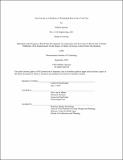Taxi activity as a predictor of residential rent in New York City
Author(s)
Caporaso, Philip(Philip S.)
Download1135875319-MIT.pdf (379.7Kb)
Other Contributors
Massachusetts Institute of Technology. Center for Real Estate. Program in Real Estate Development.
Advisor
Alex van de Minne.
Terms of use
Metadata
Show full item recordAbstract
Real estate developers and investors have a vested interest in discovering new techniques for estimating the direction and magnitude of changes in residential rent within a neighborhood. This study hypothesizes, and finds evidence, that taxi activity is a proxy for changing income and neighborhood quality as well as an indicator of gentrification. Novel research is performed to determine if taxi activity is a significant predictor of rents in New York City at the neighborhood level. Nine OLS regression models are created using data about 1,466,234,991 taxi pickups and drop-offs, median rent, and median income across 188 neighborhoods in New York City in the years of 2010-2015. In all nine models, taxi activity is found to be a statistically significant predictor of rent at 99% confidence. This study finds that a I standard deviation positive shock in taxi drop-offs will result in a 0.009% 0.155% higher rent the next year on average.
Description
This electronic version was submitted by the student author. The certified thesis is available in the Institute Archives and Special Collections. Thesis: S.M. in Real Estate Development, Massachusetts Institute of Technology, Program in Real Estate Development in conjunction with the Center for Real Estate, 2019 Cataloged from PDF version of thesis. Includes bibliographical references (pages 28-29).
Date issued
2019Department
Massachusetts Institute of Technology. Center for Real Estate. Program in Real Estate Development; Massachusetts Institute of Technology. Center for Real EstatePublisher
Massachusetts Institute of Technology
Keywords
Center for Real Estate. Program in Real Estate Development.